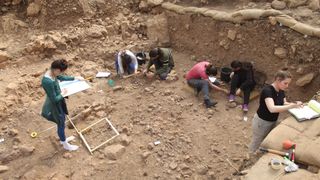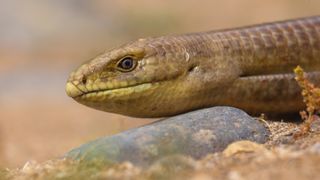First evidence that ancient humans ate snakes and lizards is unearthed in Israel
Numerous bones were found at a site dating to the late Pleistocene

People who lived 15,000 years ago in what is now Israel feasted on snakes and lizards, archaeologists have discovered.
Prior excavations in the Levant, a geographic region that historically included Israel, Palestine, Lebanon, and parts of Syria and Jordan, unearthed thousands of bones belonging to lizards and snakes. Animal bones are usually found where ancient people once lived if the animals were being eaten. But it was unknown if lizards and snakes were part of the human diet or if their bones were left behind by other predators.
By experimenting on the bones of modern squamates — the group that includes lizards and snakes — researchers developed visual references for different types of surface damage, such as erosion, burning or digestion by birds of prey. When the scientists compared these patterns to damage in squamate bones from the el-Wad Terrace, a cave site near Israel's Mount Carmel that was occupied by humans between 11,500 and 15,000 years ago, they determined that many of the ancient bones there had been eaten by people.
Related: Photos: Ancient burial and metal tool from southern Levant
Human communities in the Levant at this time were known as Natufian. They were primarily hunters and foragers and are considered the first non-nomadic society; the semi-sedentary habits of Natufian culture were likely a precursor to humans settling down and becoming farmers.
At the el-Wad Terrace settlement, the site was densely layered with animal remains, of which "a high percentage" belonged to lizards and snakes, the researchers reported in a new study, published online June 10 in the journal Scientific Reports.
The quantity of squamate bones at the site was astonishing; that alone hinted at human consumption as a possible explanation, said lead study author Ma'ayan Lev, a doctoral candidate in archaeology at the University of Haifa in Israel.
Sign up for the Live Science daily newsletter now
Get the world’s most fascinating discoveries delivered straight to your inbox.
"I have worked on various zooarchaeological assemblages and have not encountered such large numbers before," Lev told Live Science in an email.

Thousands of bones
Nearly 3,000 squamate remains — mostly vertebrae — were collected at el-Wad, making up about 33% of all the animal remains at the site. The most common squamate species was the legless European glass lizard (Pseudopus apodus), followed by the large whip snake (Dolichophis jugularis) the eastern Montpellier snake (Malpolon insignitus) and the common viper (Daboia palaestinae).
When archaeologists examine animal bones, they look for certain telltale marks that indicate the animals had been butchered and eaten by humans. Detecting such evidence in the small bones of snakes and lizards is difficult, and other types of damage such as erosion can make those marks even harder to spot, according to the study.
To more accurately interpret the different types of damage affecting bones at el-Wad, the researchers conducted "weathering experiments" where they observed how modern bones were damaged through digestion by birds of prey; weathering from erosion; burning and trampling.
These experiments enabled the scientists to observe how weathering changes the surface of squamate bones. It also helped them to spot digestion marks "even when overlapping processes such as weathering and erosion by sediment occurred," Lev explained.

"The most surprising find was the butchery marks on several large whip snake vertebrae," which appeared in identical locations on different bones and even on the same side of the bones, Lev said in the email.
In addition to cut marks, most of the bones from large whip snakes and glass lizards showed no signs of being digested by raptors, and "were most probably consumed by the inhabitants of the site," the study authors wrote. Other squamate species — "mostly the eastern Montpellier snake, the viper, and small lizards and snakes" — likely fell prey to raptors or died naturally, according to the study.
This discovery provides valuable clues about eating habits in the Levant's Natufian culture, as humans adapted to more agrarian lifestyles, Lev told Live Science.
"We hope that this study will shed light on the importance of squamate remains in the Natufian, and will provide a tool to discern between cultural and natural squamate accumulations in other zooarchaeological Natufian studies," Lev said.
- Photos: 5,000-year-old stone monument in Israel
- In photos: 130,000-year-old evidence of humans in California
- Back to the Stone Age: 17 key milestones in Paleolithic life
Originally published on Live Science.
OFFER: Save 45% on 'How It Works' 'All About Space' and 'All About History'!
For a limited time, you can take out a digital subscription to any of our best-selling science magazines for just $2.38 per month, or 45% off the standard price for the first three months.

Mindy Weisberger is an editor at Scholastic and a former Live Science channel editor and senior writer. She has reported on general science, covering climate change, paleontology, biology, and space. Mindy studied film at Columbia University; prior to Live Science she produced, wrote and directed media for the American Museum of Natural History in New York City. Her videos about dinosaurs, astrophysics, biodiversity and evolution appear in museums and science centers worldwide, earning awards such as the CINE Golden Eagle and the Communicator Award of Excellence. Her writing has also appeared in Scientific American, The Washington Post and How It Works Magazine.
Most Popular


